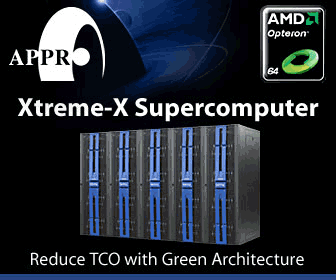ACADEMIA
Researchers, NVIDIA collaborate on petascale GPU computing
 To ensure these capabilities are available when petascale systems deploy, researchers must develop new programming paradigms and advanced code development tools for science, engineering, digital arts and humanities, and a variety of interdisciplinary applications. The Institute for Advanced Computing Applications and Technologies (IACAT) at the University of Illinois at Urbana-Champaign recently launched a project designed to empower science and engineering researchers by enabling their applications to run 100 times faster and at much lower cost than on traditional parallel processing techniques. This effort is led by Wen-mei Hwu, the Sanders-AMD Endowed Chair in Electrical and Computer Engineering at Illinois and a research professor in Illinois' Coordinated Science Laboratory. Also joining in the effort are researchers at LSU's Center for Computation and Technology (CCT) and NVIDIA Corporation. Together, researchers from these sites will develop models, tools, and applications communities that will leverage the use of GPUs for petascale computing. "Each member of the partnership brings unique, critical ingredients to the table," Hwu said. "Through this collaboration, we will be able to attack the problem in a way that will benefit the entire science and engineering community." "This partnership not only allows us to develop the tools and technologies our researchers will need to access these future systems, but will give us the opportunity to make breakthroughs that will benefit the global scientific computing community," said CCT Director Ed Seidel. The project will focus on four key areas:
To ensure these capabilities are available when petascale systems deploy, researchers must develop new programming paradigms and advanced code development tools for science, engineering, digital arts and humanities, and a variety of interdisciplinary applications. The Institute for Advanced Computing Applications and Technologies (IACAT) at the University of Illinois at Urbana-Champaign recently launched a project designed to empower science and engineering researchers by enabling their applications to run 100 times faster and at much lower cost than on traditional parallel processing techniques. This effort is led by Wen-mei Hwu, the Sanders-AMD Endowed Chair in Electrical and Computer Engineering at Illinois and a research professor in Illinois' Coordinated Science Laboratory. Also joining in the effort are researchers at LSU's Center for Computation and Technology (CCT) and NVIDIA Corporation. Together, researchers from these sites will develop models, tools, and applications communities that will leverage the use of GPUs for petascale computing. "Each member of the partnership brings unique, critical ingredients to the table," Hwu said. "Through this collaboration, we will be able to attack the problem in a way that will benefit the entire science and engineering community." "This partnership not only allows us to develop the tools and technologies our researchers will need to access these future systems, but will give us the opportunity to make breakthroughs that will benefit the global scientific computing community," said CCT Director Ed Seidel. The project will focus on four key areas:
- Developing parallel programming models and frameworks, allowing easy access to GPUs for application engineers and scientists. This includes support for graphics processor kernel code through the Cactus Computational Toolkit, in-situation feature analysis and rendering capabilities for the resulting multiscale data, and high-level parallel programming models for seamless portability of application code between GPUs and multi-core central processing units.
- Creating new performance-tuning tools that help automate optimizing applications for GPUs. This capability will enable broader use of parallel programming frameworks for petascale applications. It also will allow the same application source to achieve the best possible performance on both GPUs and multi-core central processing units.
- Implementing laboratory test-beds at CCT's Advanced Computer Architecture Laboratory and IACAT to evaluate and improve the models and tools for deployment in a petascale environment. In particular, the research groups will deploy advanced graphics processor hardware test-bed environments for developing tools and testing applications both universities. NVIDIA Corporation will support test-bed development by donating Tesla GPU Computing processors.
- Researchers from both universities will develop application communities in key engineering and scientific areas, including computational biophysics, astrophysics and computational fluid dynamics, along with emerging disciplines that rely on high-performance computing, such as digital arts and humanities. This will provide scenarios for researchers to test the developing applications and tools.
"The combination of CUDA parallel programming tools and NVIDIA Tesla GPU Computing products is driving a fundamental change in the world of scientific computing and delivering unprecedented levels of price performance to research facilities," said David Kirk, chief scientist at NVIDIA Corporation and co-instructor of the University of Illinois course on Programming Massively Parallel Processors. "We are very excited to be working with LSU's CCT and IACAT to encourage discovery and innovation and create exciting new opportunities for researchers and scientists." CCT and IACAT will organize joint workshops at both sites and support individual travel for coordinating research activities. The workshops will invite experts in computer science and the application areas to communicate results from cutting-edge research, bring a forum to discuss the use of graphic processors in practical environments, and provide education opportunities for students.
